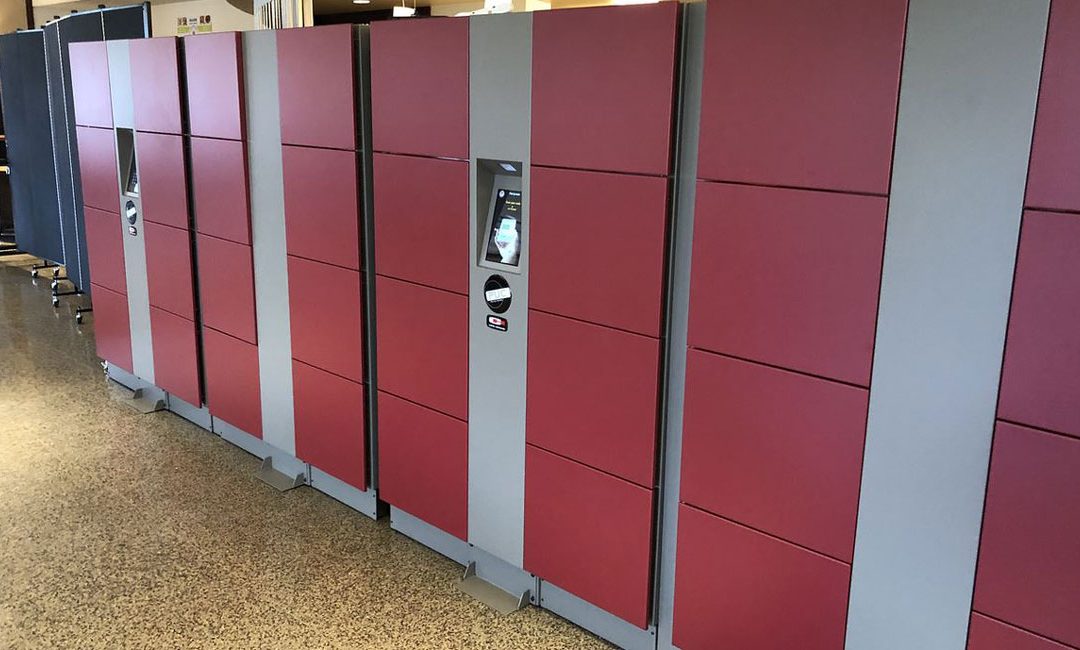When everything shut down, Boston College had to quickly rethink foodservice to ensure a safe way to provide staff and students with food. They looked to an automated food locker and jumped headfirst into the tricky process of off-premises technology innovation.
The popular Hillside Café in the heart of campus served around 8,000 people a day, but it simply wasn’t large enough to do social distancing. When COVID-19 hit, Megan O’Neill, associate director of restaurant operations for the college, said it wasn’t safe to open when students returned for class.
She and the foodservice team had already been investigating automated lockers, but had pushed the project to a back burner when they couldn’t find what they wanted. O’Neill said Carter-Hoffman, an equipment sub brand under Middleby, worked closely with them as they had developed a line of Pickup Cabinets branded PUC to support the demand for off-premise dining via an automated cabinet solution.
Shortly thereafter, a big bank of automated lockers from Carter-Hoffmann, and then the real work began for O’Neill and Perfect Company, a technology company that Carter-Hoffmann/Middleby partnered with to navigate the softer side of the lockers for customers like O’Neill and Boston College.
He said the company has been working in the restaurant space for about two years, partnering with companies like Middleby on hardware and figuring out the software between staff, customers and the hardware.
“Carter-Hoffman Middleby really stepped up, we built the whole thing in about two-months’ time, hardware and software,” said Wallace. “Some of the challenges we had were around integrating with their order system, and that vendor was slammed because all their customers were turning on delivery. We had to come up with a very easy way to do the integration.”
Ultimately, he said the simple version was sending orders to the system and the lockers in parallel. Then it was a matter of figuring out the operations.
“We process the orders and we assign them to one cabinet or another and balance it. Then we drive an IP printer at the expo station,” said Wallace. “We print the ticket with a QR code on it. As the crew crew assembles the order, with that ticket, all they have to do is walk over, scan the code and it assigns a locker.”
When the locker identifies something is inside, it starts a countdown of 20 minutes for the end consumer to come and get their food.
As the first school to use the technology, Boston College experienced some unforeseen bugs.
Some of the text messages didn’t work and certain plans that didn’t go through, which was a big issue, O’Neill said, adding, “It’s not that it was a long list of issues but the perfect example is that text messaging, some [cell service] companies wouldn’t take the information and it wasn’t one vendor.”
That’s a key part of the breakneck pace of restaurant technology. There are big promises around efficiency and savings (Wallace said the average customer they work with sees a 0.5 to 4 percent savings), but the whole system has to work. To get through it, both the foodservice entity, the partners have to have a bit of an entrepreneurial mindset, especially for new innovations like these lockers.
“It really is a solution, not a piece of equipment. A lot of people focus on the hardware piece, but it’s integrating with the kitchen. To that point, we have not yet delivered the same solution twice, it’s been really fascinating,” said Wallace.
O’Neill said she’d be happy with a cut of the proceeds for helping with the test case, and fielding the “very vocal” feedback from students and staff. She and her team are, however, eager to keep going. The school is already rolling out the second set of lockers across campus.
She said it all started with safety, but the efficiency and data keep the solution especially exciting.
“It allows us to put out 30 lockers of food without a person talking to 30 people to get their order. The ability to scan a ticket, the locker pops open and you slide a meal in is a very efficient way of doing it,” said O’Neill. “I had some managers that daresay argued over the lockers. When they saw it, they said, ‘Oh my God it’s awesome.'”
Cal Brokamp, manager of procurement and vendor relations at Boston College said data is especially exciting for her—something that’s not possible with a simple table or shelf.
“We can see everything; you can see how long it’s been in a locker. You can see how quickly it takes for a customer to get a text to get an order. Those stats help us move forward,” said Brokamp. “A table works, but right now everyone is focusing on data and we now have that.”
All that data is married with the ordering system for a close look at just how efficient the model is. She said average “dwell time” for an order is just nine minutes, and a quarter of orders are picked up in just three minutes from when the customer gets a text and grabs their food.


